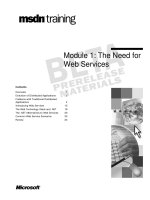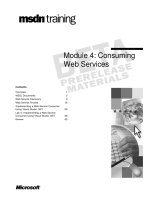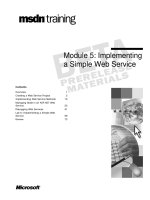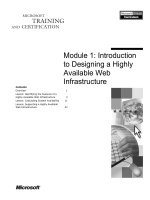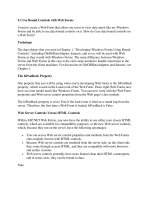Designing Web Interfaces pdf
Bạn đang xem bản rút gọn của tài liệu. Xem và tải ngay bản đầy đủ của tài liệu tại đây (8.13 MB, 334 trang )
Download at WoweBook.Com
Designing Web Interfaces
Download at WoweBook.Com
Download at WoweBook.Com
Designing Web Interfaces
Bill Scott and Theresa Neil
Beijing · Cambridge · Farnham · Köln · Sebastopol · Taipei · Tokyo
Download at WoweBook.Com
Designing Web Interfaces
by Bill Scott and Theresa Neil
Copyright © 2009 Bill Scott and Theresa Neil. All rights reserved.
Printed in the United States of America.
Published by O’Reilly Media, Inc., 1005 Gravenstein Highway North, Sebastopol, CA 95472.
O’Reilly books may be purchased for educational, business, or sales promotional use. Online editions are
also available for most titles (safari.oreilly.com). For more information, contact our corporate/institutional
sales department: 800-998-9938 or
Editor:
Mary Treseler
Production Editor:
Rachel Monaghan
Copyeditor:
Colleen Gorman
Proofreader:
Rachel Monaghan
Indexer:
Julie Hawks
Cover Designer:
Karen Montgomery
Interior Designer:
Ron Bilodeau
Illustrator:
Robert Romano
Printing History:
January 2009: First Edition.
Nutshell Handbook, the Nutshell Handbook logo, and the O’Reilly logo are registered trademarks of
O’Reilly Media, Inc. Designing Web Interfaces, the image of a Guianan cock-of-the-rock, and related trade
dress are trademarks of O’Reilly Media, Inc.
Many of the designations used by manufacturers and sellers to distinguish their products are claimed as
trademarks. Where those designations appear in this book, and O’Reilly Media, Inc. was aware of a trade-
mark claim, the designations have been printed in caps or initial caps.
While every precaution has been taken in the preparation of this book, the publisher and authors assume
no responsibility for errors or omissions, or for damages resulting from the use of the information con-
tained herein.
This book uses Repkover,™ a durable and flexible lay-flat binding.
ISBN: 978-0-596-51625-3
[V] [6/09]
Download at WoweBook.Com
Contents
Foreword ix
Preface xi
Make It DirecPrinciple One: t
In-Page Editing1. 3
Single-Field Inline Edit 4
Multi-Field Inline Edit 8
Overlay Edit 11
Table Edit 15
Group Edit 18
Module Configuration 21
Guidelines for Choosing Specific Editing Patterns 23
Drag and Drop2. 25
Interesting Moments 26
Purpose of Drag and Drop 29
Drag and Drop Module 30
Drag and Drop List 40
Drag and Drop Object 46
Drag and Drop Action 52
Drag and Drop Collection 57
The Challenges of Drag and Drop 59
Download at WoweBook.Com
vi Contents
Direct Selection3. 61
Toggle Selection 62
Collected Selection 67
Object Selection 70
Hybrid Selection 72
Keep It LightweighPrinciple Two: t
Contextual Tools4. 79
Interaction in Context 79
Fitts’s Law 80
Contextual Tools 81
Always-Visible Tools 81
Hover-Reveal Tools 85
Toggle-Reveal Tools 91
Multi-Level Tools 93
Secondary Menu 98
Stay on the PagPrinciple Three: e
Overlays5. 105
Dialog Overlay 107
Detail Overlay 112
Input Overlay 119
Inlays6. 123
Dialog Inlay 123
List Inlay 127
Detail Inlay 132
Tabs 134
Inlay Versus Overlay? 136
Virtual Pages7. 137
Virtual Scrolling 137
Inline Paging 142
Download at WoweBook.Com
Contents vii
Scrolled Paging: Carousel 147
Virtual Panning 149
Zoomable User Interface 151
Paging Versus Scrolling 155
Process Flow8. 157
Google Blogger 157
The Magic Principle 158
Interactive Single-Page Process 160
Inline Assistant Process 164
Dialog Overlay Process 168
Configurator Process 171
Static Single-Page Process 174
Provide an InvitatioPrinciple Four: n
Static Invitations9. 181
Call to Action Invitation 181
Tour Invitation 185
Dynamic Invitations10. 191
Hover Invitation 191
Affordance Invitation 196
Drag and Drop Invitation 200
Inference Invitation 209
More Content Invitation 210
The Advantage of Invitations 213
Use TransitionPrinciple Five: s
Transitional Patterns11. 217
Brighten and Dim 217
Expand/Collapse 222
Self-Healing Fade 227
Animation 228
Spotlight 231
Download at WoweBook.Com
viii Contents
Purpose of Transitions12. 233
Engagement 233
Communication 234
React ImmediatelPrinciple Six: y
Lookup Patterns13. 253
Auto Complete 253
Live Suggest 257
Live Search 262
Refining Search 268
Feedback Patterns14. 275
Live Preview 275
Progressive Disclosure 284
Progress Indicator 286
Periodic Refresh 292
Principles and Patterns for Rich InteractionEpilogue: 295
Index 297
Download at WoweBook.Com
Chapter 1
Foreword
In architecture, parti refers to the underlying concept of a building.
*
Will it be an aca-
demic structure aimed at increasing cross-disciplinary collaboration or a theater flexible
enough to support quick set changes? To bring a specific parti to life, architects must not
only define its essence but also know how to manage the huge number of considerations
that ultimately impact its construction.
Design principles are the guiding light for any architect’s parti. They define and commu-
nicate the key characteristics of a building to a wide variety of stakeholders, including cli-
ents, builders, city planners, and engineers. Design principles articulate the fundamental
goals that all decisions can be measured against and thereby keep the pieces of a project
moving toward an integrated whole. But design principles are not enough.
Every aspect of a building from an attic to a Zen garden has a set of opportunities and
limitations that can either add to or detract from the main concept or parti. These include
standard dimensions, spacing requirements, aesthetics, physical limitations, and more.
Architects who want to bring coherent visions to life need to learn the detailed ins and
outs of these design considerations so they can select the best solutions from the options
available.
This combination of design principles at the top and design considerations at the bottom
is what allows architects to fill in the middle with meaningful buildings that enable people
and organizations to interact, communicate, and get things done.
Those of us whose parti is bringing rich web applications to life can also benefit from a
framework of design principles and considerations to guide us. In these pages, Bill Scott
and Theresa Neil give us just that. Through 30 years of designing and developing soft-
ware, Bill and Theresa have been the consummate taxonomists—naming, documenting,
and sharing in loving detail what makes rich interactions succeed and fail.
* The term parti comes from Matthew Frederick’s book 101 Things I Learned in Architecture School (MIT Press).
Download at WoweBook.Com
x Foreword
The breadth of solutions they have encountered has given them a unique perspective
on the design principles behind the most successful rich interactions on the Web. From
“make it direct” to “react immediately,” the principles he outlines in this book are your
yardstick for measuring the value that rich interactions bring to your web application.
Through in-depth descriptions of context and trade-offs, Bill and Theresa support each
principle with the design considerations and best practices you need to make informed
decisions. Engineers, product managers, marketers, and designers can rally around and
continually return to these principles and considerations to ensure that everyone is evalu-
ating the impact of design decisions the same way.
This combination of rich web interaction design principles at the top and design consider-
ations at the bottom allows web designers to fill in the middle with meaningful structures
that enable people and organizations to interact, communicate, and get things done. Just
like our friends, the architects.
So, dive in and immerse yourself in the direction and details you need to bring your rich
web application partis to life!
—Luke Wroblewski
October 2008
Senior Director, Product Ideation and Design, Yahoo! Inc.
Author, Web Form Design: Filling in the Blanks (Rosenfeld Media)
Author, Site-Seeing: A Visual Approach to Web Usability (Wiley)
Download at WoweBook.Com
Chapter 1
Preface
What Happened
My (Bill’s) first personal computer was a Radio Shack Color Computer (circa
1981)— complete with a chiclet-style keyboard. The first few months the main user inter-
face was the command line, typing in COLOR BASIC code.
Later, an upgrade to an Apple IIe brought a nicer keyboard with lots of games. But the
interface was basically the same. The command-line and text-driven menu systems ruled
the day. When the IBM PC came on the scene it brought more of the same. Lotus 123,
which was the state-of-the-art spreadsheet application at the time, was controlled by a set
of cryptic keystrokes. Not much of a user experience.
Then an interface revolution started. The Macintosh arrived in 1984, and shortly after
its introduction, I brought one home. The mouse opened the door to a brand-new world
of interaction. Instead of having to learn archaic commands to navigate through text-
based menus, interaction in this new environment happened naturally in a direct, intui-
tive manner.
OK, you are probably thinking, so what? That was 1984. This is now. What does this have
to do with a book about designing web interfaces?
Everything.
For most of the history of the Web, sites and applications were marked by primitive inter-
faces—just like the early desktop era. Most sites were built from two events:
Clicking hyperlinks•
Submitting forms•
Try to create an interesting user experience from just those two events. And, to add insult
to injury, every click and every submit was punctuated with a page refresh. Creating a
seamless user experience was next to impossible.
Download at WoweBook.Com
xii Preface
Interestingly, the technologies have existed for many years to get around these limitations.
But it was only after they became widely available across the most common browsers
that developers could count on them in their everyday development. In 2004, Google
launched Gmail and Google Maps using a set of techniques later dubbed Ajax by Jesse
James Garrett.
The difference was dramatic. The Ajax-enabled Google Maps now interacted more like a
desktop application with real-time pan-and-zoom—all with no page refresh. Mapquest,
on the other hand, behaved like most other web applications at the time, refreshing the
page each time the map was repositioned or zoomed. The contrast was clear between the
old world of the Web and the new world as enabled by Ajax.
Why We Wrote This Book
While I got the chance to live through the first interface revolution for the desktop (even
writing one of the first games for the Macintosh
*
), my coauthor Theresa Neil lived through
the second revolution on the Web.
A few years ago our paths crossed at Sabre (parent company of Travelocity). Together we
founded a user experience design team and worked to improve dozens of products, per-
forming heuristic evaluations and participating in full web application redesigns. From
that work, we distilled a number of user interface design patterns as well as anti-patterns
(common mistakes to avoid).
From there I went to Yahoo! and got to play an active role in defining the Ajax interface
revolution on the Web. One of my contributions at Yahoo! was to publicly launch the
Yahoo! Design Pattern Library. As Yahoo!’s Ajax Evangelist, I met and brainstormed with
many of Yahoo!’s best minds on what it means to take these new interactions and apply
them to the unique context of the Web. As a result, over the last few years, I have given
countless talks on this subject, sharing best practices with web developers and designers
from around the world.
At the same time Theresa struck out as an interface designer in her own consultancy. In
her work she has continued to refine the initial set of design patterns and principles while
leading the design for 30+ live rich internet applications—enterprise applications as well
as public-facing websites. These patterns have given Theresa and her clients a common
vocabulary and a set of standards to work with for new application design and existing
system redesign.
This book is an outgrowth of our experience—a distillation of the combined 30+ years
that Theresa and I share. After repeated requests, we decided the best way to share this
with a larger audience was to put the material into book form.
* GATO was published by Spectrum Holobyte in 1985.
Download at WoweBook.Com
Preface xiii
What This Book Is About
This book is not about information architecture, although you will find information archi-
tecture principles alluded to throughout it. And this book is also not about visual design,
although you will find that the backdrop of good visual design is assumed throughout.
This book is about interaction design: specifically, interaction design on the Web. And
even more specifically, about rich interaction design on the Web. It is a distillation of best
practices, patterns, and principles for creating a rich experience unique to the Web.
By unique I mean that the Web comes with its own context. It is not the desktop. And while
over time the lines between desktop and Web blur more and more, there is still a unique
aspect to creating rich interactions on the Web. Editing content directly on the page (e.g.,
In-Page Editing, as we discuss in Chapter 1) borrows heavily from the desktop—but has
its own unique flavor when applied to a web page. This book explores these unique rich
interactions as set of design patterns in the context of a few key design principles.
Design Patterns
What do we mean by design patterns?
Christopher Alexander coined the term “patterns” in his seminal work A Pattern Lan-
guage: Towns, Buildings, Construction (Oxford University Press) to catalog common ar-
chitectural solutions to human activities. He described a pattern as:
…a problem which occurs over and over again in our environment, and then de-
scribes the core of the solution to that problem…
Patterns were later applied to software in the book Design Patterns: Elements of Reusable
Object-Oriented Software (Addison-Wesley), by the Gang of Four (Erich Gamma, Rich-
ard Helm, Ralph Johnson, and John M. Vlissides). A few years later design patterns were
extended to the realm of user interface design.
*
It is the latter form of patterns that we present in this book: interaction design patterns.
You will find 75+ patterns illustrating the most common techniques used for rich web
interaction. Each design pattern is illustrated by examples from various websites. Since
the patterns described are interactive, we use a generous amount of figures to explain the
concept. We tease out the nuances for a given solution as well as identify patterns to be
avoided (anti-patterns). Best practice sections call out suggestions along the way.
The patterns are presented in the context of six design principles, which form the frame-
work for the book:
* See works such as Jenifer Tidwell’s Designing Interfaces: Patterns for Effective Interaction Design (O’Reilly) and
the pattern library of Martijn van Welie ( />Download at WoweBook.Com
xiv Preface
Principle One: Make It Direct
As Alan Cooper states: “Where there is output, let there be input.” This is the princi-
ple of direct manipulation. For example, instead of editing content on a separate page,
do it directly in context. Chapters 1–3 in this principle include patterns for “In-Page
Editing,” “Drag and Drop,” and “Direct Selection.”
Principle Two: Keep It Lightweight
While working on a redesign of Yahoo! 360 the designer, Ericson deJesus, used the
phrase “light footprint” to describe the need to reduce the effort required to interact
with the site. A primary way to create a light footprint is through the use of Con-
textual Tools. This principle explores the various patterns for these in Chapter 4,
“Contextual Tools.”
Principle Three: Stay on the Page
The page refresh is disruptive to the user’s mental flow. Instead of assuming a page
refresh for every action, we can get back to modeling the user’s process. We can de-
cide intelligently when to keep the user on the page. Ways to overlay information or
provide the information in the page flow are discussed in Chapters 5 and 6, “Over-
lays” and “Inlays”, respectively. Revealing dynamic content is discussed in Chapter
7, “Virtual Pages.” In the last chapter of this section, Chapter 8, we discuss “Process
Flows,” where instead of moving from page to page, we can create in-page flows.
Principle Four: Provide an Invitation
Discoverability is one of the primary challenges for rich interaction on the Web. A
feature is useless if users don’t discover it. A key way to improve discoverability is to
provide invitations. Invitations cue the user to the next level of interaction. This sec-
tion, including Chapters 9 and 10, looks at “Static Invitations,” those offered statically
on the page, and “Dynamic Invitations,” those that come into play in response to the
user.
Principle Five: Use Transitions
Animations, cinematic effects, and various other types of visual transitions can be
powerful techniques. We explore engagement and communication in Chapter 11,
looking at a set of the most common “Transitional Patterns,” and Chapter 12 is devot-
ed to the “Purpose of Transitions.” A number of anti-patterns are explored as well.
Principle Six: React Immediately
A responsive interface is an intelligent interface. This principle explores how to make
a rich experience by using lively responses. In Chapter 13, a set of “Lookup Patterns”
is explored, including Live Search, Live Suggest, Refining Search, and Auto Com-
plete. In Chapter 14, we look at a set of “Feedback Patterns,” including Live Previews,
Progressive Disclosure, Progress Indication, and Periodic Refresh.
Download at WoweBook.Com
Preface xv
Who Should Read This Book
Designing Web Interfaces is for anyone who specifies, designs, or builds web interfaces.
Web designers will find the principles especially helpful as they form a mental framework,
defining a philosophy of designing nuanced rich interactions. They will also find the pat-
terns a welcome addition to their design toolbox, as well as find the hundreds of provided
examples a useful reference. And of course the best practices should provide a nice check-
list reminder for various interaction idioms.
Product managers will find the patterns and examples to be excellent idea starters as they
think through a new business problem. Though this book does not provide programming
solutions, web developers will nevertheless appreciate the patterns, as they can be mapped
directly into specific code solutions. For everyone involved, the patterns form a vocabu-
lary that can span product management, design, and engineering, which in the end forms
the basis for clearer cross-team communication.
You’ll also find that whether you are just starting out or you are a grizzled veteran, the
wealth of real-world examples in the context of design principles and patterns will be a
benefit to your daily work.
What Comes with This Book
This book has a companion website () that serves as an
addendum containing updated examples; additional thoughts on the principles, patterns,
and best practices; and helpful links to articles and resources on designing web interfaces.
All of the book’s diagrams and figures are available under a Creative Commons license
for you to download and use in your own presentations. You’ll find them at Flickr (http://
www.flickr.com/photos/designingwebinterfaces/).
Conventions Used in This Book
This book uses the following typographic conventions:
Italic
Used for example URLs, names of directories and files, options, and occasionally for
emphasis.
Bold text
Indicates pattern names.
Tip
This indicates a tip, suggestion, or general note.
Download at WoweBook.Com
xvi Preface
Using Examples
You can find all of the figure examples on our companion Flickr site ( />photos/designingwebinterfaces). The figures are available for use in presentations or other
derivative works provided you respect the Creative Commons license and provide attri-
bution to this work. An attribution usually includes the title, author, publisher, and ISBN.
For example: “Designing Web Interfaces, by Bill Scott and Theresa Neil, Copyright 2009
Bill Scott and Theresa Neil, 978-0-596-51625-3.”
If you feel your use of examples falls outside fair use or the permission given above, feel
free to contact us at
We’d Like to Hear from You
We have tested and verified the information in this book to the best of our ability, but you
may find that features have changed or that we may have made a mistake or two (shocking
and hard to believe). Please let us know about any errors you find, as well as your sugges-
tions for future editions by writing to:
O’Reilly Media, Inc.
1005 Gravenstein Highway North
Sebastopol, CA 95472
800-998-9938 (in the United States or Canada)
707-829-0515 (international or local)
707-829-0104 (fax)
We have a web page for this book where we list examples and any plans for future editions.
You can access this information at:
/>You can also send messages electronically. To be put on the mailing list or request a cata-
log, send an email to:
To comment on the book, send an email to:
For more information about our books, conferences, Resource Centers, and the O’Reilly
Network, see our website at:
Download at WoweBook.Com
Preface xvii
Safari Books Online
When you see a Safari® Books Online icon on the cover of your favorite
technology book, that means the book is available online through the
O’Reilly Network Safari Bookshelf.
Safari offers a solution that’s better than e-books. It’s a virtual library that lets you easily
search thousands of top tech books, cut and paste code samples, download chapters, and
find quick answers when you need the most accurate, current information. Try it for free
at .
Acknowledgments
Bill’s Acknowledgments
Writing this book was not just the effort of Theresa Neil and myself. There are many di-
rect contributors but even more that indirectly inspired us.
Most importantly I wish to thank Ruth. You are my wonderful wife of 30 years, my friend,
and an amazing mother. Without your patience and support I could not have gotten this
book finished.
I am deeply indebted to my editors at O’Reilly. Double kudos go to Mary Treseler, who
patiently cajoled Theresa and I to complete this work. You provided valuable feedback
early in the process. Thanks to the rest of the team that brought this book to life: Rachel
Monaghan, Marlowe Shaeffer, Ron Bilodeau, Colleen Gorman, Adam Witwer, and Robert
Romano, to name a few.
Anyone who has written a book also knows that the technical reviewers are your criti-
cal test market. Thanks for the helpful praise and constructive criticism from Christian
Crumlish, Dan Saffer, Luke Wroblewski, Juhan Sonin, Kevin Arthur, and Alan Baumgarten.
Though I could not address every issue, I took each comment seriously and they had a
significant impact on the finished product.
I owe a lot to my time at Yahoo!. Thanks to Erin Malone for sending me an email out
of the blue, which eventually led to her hiring me at Yahoo!. There I was surrounded by
brilliant people and given the opportunity to succeed. To Erin, Matt Leacock, and Chanel
Wheeler for founding the Yahoo! Design Pattern Library. Thanks to Larry Tesler and
Erin, who gave me the opportunity to lead and evangelize the launch of the public Yahoo!
Design Pattern Library. It was in my role as pattern curator that I crystallized much of
the thinking contained in this book. A special thanks to the many talented designers and
developers who gave me continual feedback and inspired me with their craftsmanship.
Download at WoweBook.Com
xviii Preface
The YUI team, and in particular Nate Koechley and Eric Miraglia, for the formulation
of “Interesting Moments” grids and for the opportunity to tie the patterns to real-world
code. My co-evangelists: Douglas Crockford, Iain Lamb, Julien Lecomte, and Adam Platti.
My good friend, Darren James, who encouraged me along the way. Thanks to the many
talented designers that I got the chance to collaborate with and whose thoughts are found
sprinkled throughout this text: Karon Weber, Samantha Tripodi, Ericson deJesus, Micah
Laaker, Luke Wroblewski, Tom Chi, Lucas Pettinati, Kevin Cheng, Kathleen Watkins,
Kiersten Lammerding, Annette Leong, Lance Nishihira, and many others.
Outside of Yahoo!, my thinking was encouraged and matured by knowing/learning from
Dan Saffer (Adaptive Path), Ryan Freitas (Adaptive Path), Aza Raskin (Humanized),
Scott Robbins (Humanized), Peter Moerholz (Adaptive Path), and David Verba (Adap-
tive Path). A special debt of gratitude to those in the pattern community. Jenifer Tidwell
for pointing the way to patterns. For Martijn van Welie for his excellent pattern library.
For James Refell and Luke Wroblewski and their work on patterns at eBay. For Christian
Crumlish, the current pattern curator at Yahoo! and his clear thinking. Jesse James Garrett,
for not only giving Ajax a name, but inviting me to the first Ajax Summit and then taking
me on tour with him. Teaching in the Designing for Ajax Workshops gave me the confi-
dence to write this book and tested the material in front of a live audience.
And thanks to the many companies and conference coordinators that invited me to
speak. Sharing this material with thousands of listeners was invaluable in determining
what resonates with most designers and developers. In no particular order (listed with the
company that they invited me to speak at): Jared Spool (UIE), Ben Galbraith and Dion
Almer (Ajaxian/Ajax Experience), Kathryn McKinnon (Adobe), Jeremy Geelan (SysCon),
Rashmi Sinha (BayCHI/Slideshare), Aaron Newton (CNET), Brian Kromrey (Yahoo!
UED courses), Luke Kowalski (Oracle), Sean Kane (Netflix), Reshma Kumar (Silicon Val-
ley Web Guild), Emmanuel Levi-Valensi (People in Action), Bruno Figueiredo (SHiFT),
Matthew Moroz (Avenue A Razorfish), Peter Boersma (SIGCHI.NL), Kit Seeborg (Web-
Visions), Will Tschumy (Microsoft), Bob Baxley (Yahoo!), Jay Zimmerman (Rich Web
Experience), Dave Verba (UX Week). Other conferences and companies that I must
thank: Web Builder 2.0, eBig, PayPal, eBay, CSU Hayward, City College San Francisco,
Apple, and many others.
My deep appreciation goes to Sabre Airline Solutions, and especially Brad Jensen, who bet
on me and gave me a great opportunity to build a UX practice in his organization; and
to David Endicott and Damon Hougland, who encouraged me to bring these ideas to the
public. And to my whole team there for helping Theresa and I vet these ideas in the wild.
Many patterns in this book were born out of designing products there.
Finally, I want to thank Netflix, where I am now happily engaged in one of the best places
to work in the world. Thanks for supporting me in this endeavor and for teaching me how
to design and build great user experiences.
Download at WoweBook.Com
Preface xix
Theresa’s Acknowledgments
I would like to gratefully acknowledge the following folks:
Aaron Arlof, who provided the illustrations for this book. They are the perfect representa-
tion of the six principles.
Brad Jensen, my vice president at Sabre Airline solutions, who had me interview Bill in
the first place. Without Bill’s mentoring and training I would not be in this field.
Damon Hougland, who helped Bill and I build out the User Experience team at Sabre.
Jo Balderas, who made me learn to code.
Darren James, who taught me how to code.
All of my clients who have participated in many a white board session, enthusiastically
learning and exploring the patterns and principles of UI design, especially Steven Smith,
Dave Wilby, Suri Bala, Jeff Como, and Seth Alsbury, who allowed me to design their en-
terprise applications at the beginning of the RIA revolution. A special thanks to my current
colleagues: Scott Boms of Wishingline, Paulo Viera, Jessica Douglas, Alan Baumgarten, and
Rob Jones.
Most importantly, I wish to thank my husband for his unwavering support, and my par-
ents for their encouragement. And my son, Aaron, for letting me spend so many hours in
front of the computer.
Download at WoweBook.Com
Principle One
Make It Direct
On a recent trip to Big Sur, California, I took some photos along scenic Highway 1. After
uploading my pictures to the online photo service, Flickr, I decided to give one of the
photos a descriptive name. Instead of “IMG_6420.jpg”, I thought a more apt name would
be “Coastline with Bixby Bridge.”
The traditional way to do this on the Web requires going to the photo’s page and clicking
an edit button. Then a separate page for the photo’s title, description, and other informa-
tion is displayed. Once on the editing page, the photo’s title can be changed. Clicking
“Save” saves the changes and returns to the original photo page with the new title displayed.
Figure P1-1 illustrates this flow.
Web applications have typically led the user to a new page to perform editingFigure P1-1.
In Flickr you can edit the photo title just like this. However, Flickr’s main way to edit photos
is much more direct. In Figure P1-2 you can see that by just clicking on “IMG_6420.jpg”,
editing controls now encapsulate the title. You have entered the editing mode directly
with just a simple click.
Editing directly in context is a better user experience since it does not require switching
the user’s context. As an added bonus, making it easier to edit the photo’s title, description,
and tags means more meta-information recorded for each photo—resulting in a better
searching and browsing experience.
In Figure P1-2. Flickr, clicking directly on the title allows it to be edited inline
Download at WoweBook.Com
Make It Direct
The very first websites were focused on displaying content and making it easy to navigate
to more content. There wasn’t much in the way of interactivity. Early versions of HTML
didn’t include input forms for users to submit information. Even after both input and
output were standard in websites, the early Web was still primarily a read-only experience
punctuated by the occasional user input. This separation was not by design but due to the
limits of the technology.
Alan Cooper, in the book About Face 3: The Essentials of Interaction Design, describes the
false dichotomy.
…many programs have one place [for] output and another place [for] input, [treat-
ing them] as separate processes. The user’s mental model…doesn’t recognize a
difference.
Cooper then summarizes this as a simple rule: Allow input wherever you have output.
*
More generally we should make the interface respond directly to the user’s interaction:
Make it direct.
†
To illustrate this principle, we look at some broad patterns of interaction that can be used
to make your interface more direct. The next three chapters discuss these patterns:
Chapter 1, In-Page Editing
Directly editing of content.
Chapter 2, Drag and Drop
Moving objects around directly with the mouse.
Chapter 3, Direct Selection
Applying actions to directly selected objects.
* Cooper, Alan et al. About Face 3: The Essentials of Interaction Design (Wiley, 2007), 231.
† This is a restatement of the principle of Direct Manipulation coined by Ben Scheiderman (“Direct manipulation:
a step beyond programming languages,” IEEE Computer 16[8] [August 1983], 57–69).
Download at WoweBook.Com
Download at WoweBook.Com
Chapter 1
In-Page Editing
Content on web pages has traditionally been display-only. If something needs editing, a
separate form is presented with a series of input fields and a button to submit the change.
Letting the user directly edit content on the page follows the principle of Make It Direct.
This chapter describes a family of design patterns
*
for directly editing content in a web
page. There are six patterns that define the most common in-page editing techniques:
Single-Field Inline Edit
Editing a single line of text.
Multi-Field Inline Edit
Editing more complex information.
Overlay Edit
Editing in an overlay panel.
Table Edit
Editing items in a grid.
Group Edit
Changing a group of items directly.
Module Configuration
Configuring settings on a page directly.
The most direct form of In-Page Editing is to edit within the context of the page. First, it
means we don’t leave the page. Second, we do the editing directly in the page.
* We use the term “design patterns” to denote common solutions to common problems. Design patterns origi-
nate from Christopher Alexander’s book A Pattern Language (Oxford University Press). You can read a series
of essays from me (Bill) and others on design patterns at />Download at WoweBook.Com
